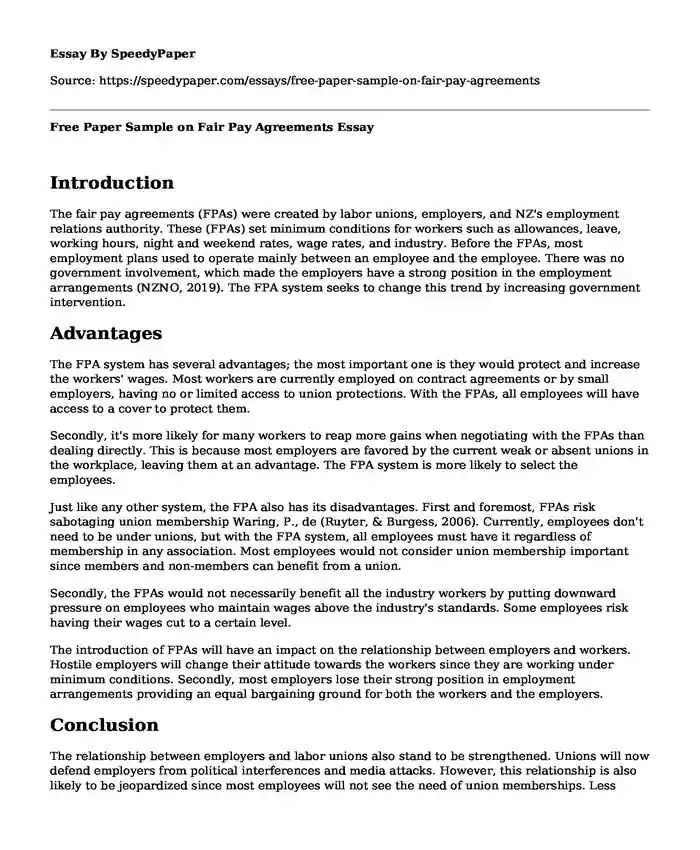
| Type of paper: | Essay |
| Categories: | Finance Employment |
| Pages: | 2 |
| Wordcount: | 449 words |
Introduction
The fair pay agreements (FPAs) were created by labor unions, employers, and NZ's employment relations authority. These (FPAs) set minimum conditions for workers such as allowances, leave, working hours, night and weekend rates, wage rates, and industry. Before the FPAs, most employment plans used to operate mainly between an employee and the employee. There was no government involvement, which made the employers have a strong position in the employment arrangements (NZNO, 2019). The FPA system seeks to change this trend by increasing government intervention.
Advantages
The FPA system has several advantages; the most important one is they would protect and increase the workers' wages. Most workers are currently employed on contract agreements or by small employers, having no or limited access to union protections. With the FPAs, all employees will have access to a cover to protect them.
Secondly, it's more likely for many workers to reap more gains when negotiating with the FPAs than dealing directly. This is because most employers are favored by the current weak or absent unions in the workplace, leaving them at an advantage. The FPA system is more likely to select the employees.
Just like any other system, the FPA also has its disadvantages. First and foremost, FPAs risk sabotaging union membership Waring, P., de (Ruyter, & Burgess, 2006). Currently, employees don't need to be under unions, but with the FPA system, all employees must have it regardless of membership in any association. Most employees would not consider union membership important since members and non-members can benefit from a union.
Secondly, the FPAs would not necessarily benefit all the industry workers by putting downward pressure on employees who maintain wages above the industry's standards. Some employees risk having their wages cut to a certain level.
The introduction of FPAs will have an impact on the relationship between employers and workers. Hostile employers will change their attitude towards the workers since they are working under minimum conditions. Secondly, most employers lose their strong position in employment arrangements providing an equal bargaining ground for both the workers and the employers.
Conclusion
The relationship between employers and labor unions also stand to be strengthened. Unions will now defend employers from political interferences and media attacks. However, this relationship is also likely to be jeopardized since most employees will not see the need of union memberships. Less employees will be represented by the FPA system thus reducing the relevance of the labor unions.
References
NZNO, H. (2019). Fair pay agreements: What’s the deal?. Kai Tiaki Nursing New Zealand, 25(2).
Waring, P., de Ruyter, A., & Burgess, J. (2006). The Australian fair pay commission: Rationale, operation, antecedents, and implications. The Economic and Labour Relations Review, 16(2), 127-146.
Cite this page
Free Paper Sample on Fair Pay Agreements. (2023, Nov 10). Retrieved from https://speedypaper.net/essays/free-paper-sample-on-fair-pay-agreements
Request Removal
If you are the original author of this essay and no longer wish to have it published on the SpeedyPaper website, please click below to request its removal:
- Budgeting and Beyond Budgeting - Essay Example
- Why Are Internal Audits Important? Essay Example
- Comparison Essay Sample: Renting Vs Owning
- Free essay on Walgreen's E-commerce activities
- Essay Example: Human Relations Document for Hobbs Motors
- Essay Sample on Company Financial Leverage
- Termination of Employment: Manager-Employee Agreement & Legal Protections - Essay Sample
Popular categories




